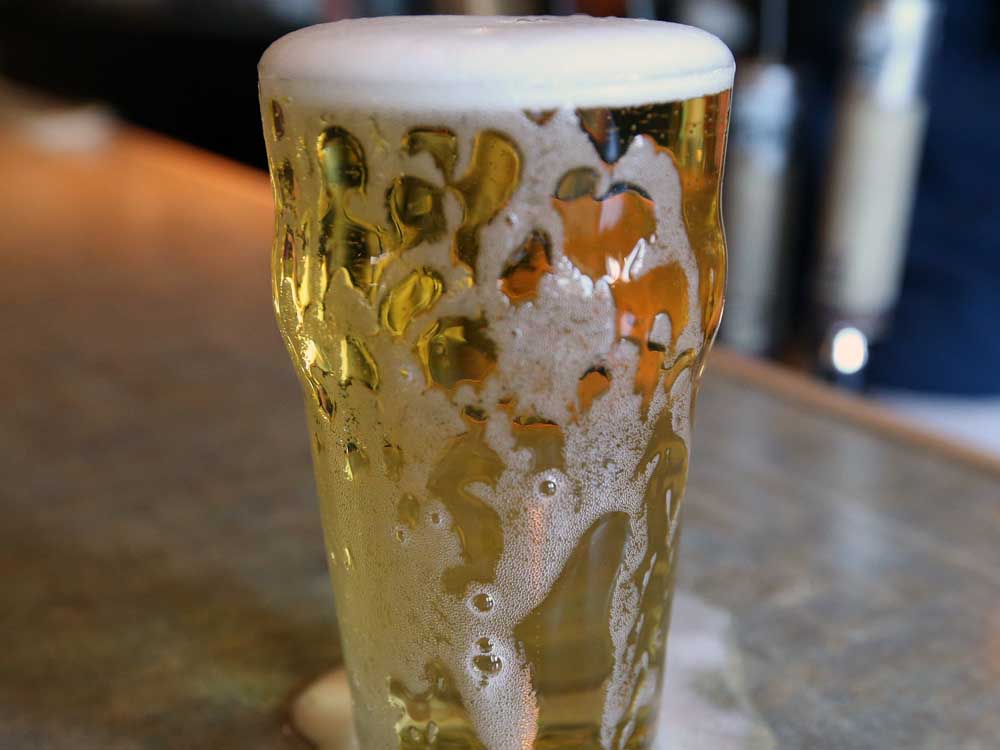Pilsner: The underrated summer beer
Published 12:00 am Thursday, July 7, 2016

- Andy Tullis / The BulletinFoam runs down the sides of a freshly poured glass of Paulina Lake Pilsner at Cascade Lakes Brewing in Bend last week..
The return of hot weather tends to bring with it a desire for light, crisp, session beers — ones that quench your thirst without being too heavy or intoxicating. Usually there is no shortage of summer ale options, including wheat beers, fruit beers, session IPAs, Kölsch and blonde ales. Personally, it’s hard to pass up a well-brewed, classic pilsner this time of year.
The pilsner style has been seeing something of a revival among craft brewers in recent years. For a long time, it simply wasn’t a style that you could often find, for several reasons. First, American breweries tend to favor ales, which ferment more quickly and under more adverse conditions than lagers. Lagers require colder, temperature-controlled conditions and can take three or more times longer to brew than ales; this ties up valuable tank space. More skill and discipline is demanded to brew them; any flaws that show up in an otherwise clean, light beer are overwhelmingly apparent.
Trending
And for many years the pilsner and similar styles were stigmatized by the American craft brewing community as being too similar to the industrialized, bland light lagers produced by the likes of Anheuser-Busch, Miller, Coors and others. California’s Stone Brewing derogatorily refers to such brews as “fizzy yellow beer.” Craft brewers rebelled with bold flavors and darker, heavier, stronger ales and an us-versus-them mentality.
Thankfully, as the industry has matured over the past three decades, brewers have been reclaiming the noble style — and bringing with it those bold flavors inspired by the old world German and Czech pilsners with a bit of American tweaking for good measure. Stone Brewing even recently announced its first-ever pilsner, Who You Callin’ WUSSIE, proclaiming that it will “steal the pilsner back from the evil clutches of corporate beer.”
The style, as well as the name, traces back to 1842 and the city of Pilsen, in what is now the Czech Republic. Brewer Josef Groll is credited with inventing the world’s first pale lager, now known as Pilsner Urquell, which was a sensation for its crystal-like clarity and golden hue. By the 1870s, German brewers began brewing their own version, which tended to be drier and hopper than the Czech style. Pilsner proved so popular that it became the inspiration for the majority of the beer brewed in the world, even today.
This includes the Bud/Miller/Coors lagers which still dominate American brewing, though these beers have been watered down over the years since Prohibition to appeal to as wide an audience as possible.
Here in Central Oregon, we are fortunate to have a number of excellent examples of the classic styles to choose from this summer. Here are several offerings from area breweries, and be sure to keep an eye out for others as well:
• Bend Brewing — Ludwig Pilsner
Trending
This summer lager from Bend’s second-oldest brewery has a hoppier profile than some of the others on this list, with a zingy, spicy bitterness. It finishes nicely dry and clean and is the perfect beer to enjoy on the patio behind the brewpub on a warm night.
• Boneyard Beer — Pabo Pils
A malty, crisp, light pale yellow beer that is eminently, as they say, “crushable.” Brewmaster Tony Lawrence is perhaps best known for his bold, in-your-face IPAs, but when it comes to the lighter styles his experience shines through, as evident with this fine lager.
• Cascade Lakes Brewing — Paulina Lake Pilsner
Redmond’s foray into the style is a tad sweeter than some of the others, a little lighter on the hop aroma, and is very drinkable. Expect a crystal-clear pour and a beautiful burnished gold color.
• Crux Fermentation Project — Crux Pilz
Modeled after the German style, Crux Pilz is crisp and clean, with complex biscuit maltiness and spicy, earthy hops. And as a bonus, Crux began canning this beer earlier this spring, releasing it in six packs.
• McMenamins Old St. Francis School — CJ’s Pilsner
Head brewer Mike “Curly” White has brewed a number of pilsners over the years. This year’s version keeps the same overall recipe as in the past, but employs a different yeast strain. White’s notes indicate that this yeast “gives a touch more overall body” to the finished beer.
• Ochoco Brewing — Steins Pilsner
This German-styled lager premiered in June, and Ochoco took the notable step of brewing this beer with a partial decoction mash (the traditional method for the style of converting the starches in the malts into sugars) and lagering the beer just above freezing.
• Silver Moon Brewing — Unkle Pilsner
Adapted from an earlier award-winning recipe (Bridge Creek Pilsner), this lager is based on the original Czech style. It’s very clear and nicely effervescent, clean-tasting with a grassy, lightly herbal hop profile.
• 10 Barrel Brewing — Pub Beer
The brewery’s distinctively nondescript white canned “Pub Beer” is brewed as a pilsner that is crisp, mellow and squarely in the German tradition. It’s lighter on the hops, which lets the malt character shine, and is served exclusively in the can.
Beyond Central Oregon, other excellent pilsners that can be found locally include Liquid Sunshine Pilsner from Breakside Brewery (Portland), Czech Pils from Buoy Beer (Astoria), and Pivo Pils from Firestone Walker (Paso Robles, California).
—Jon Abernathy is a local beer blogger and brew aficionado. His column appears in GO! every other week.








